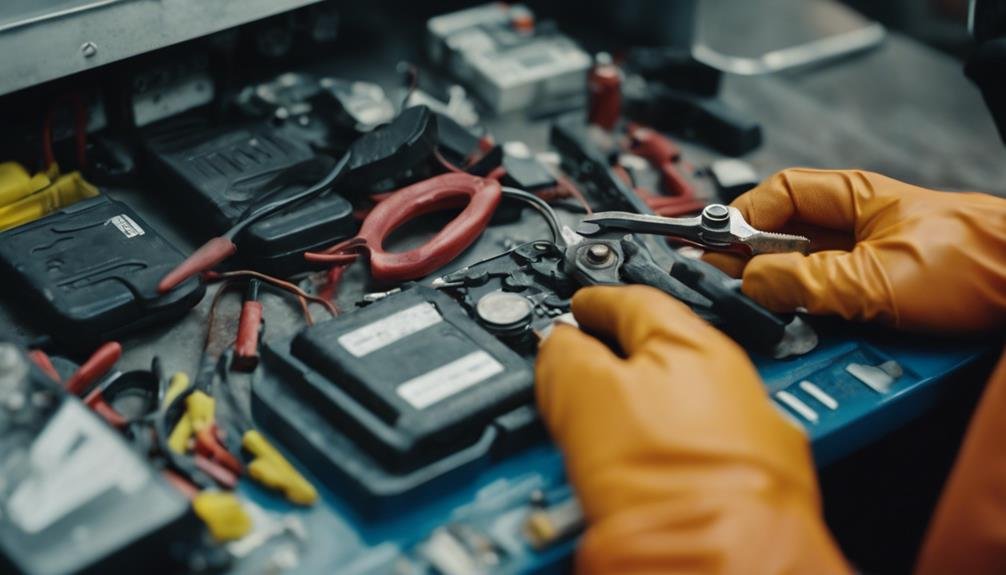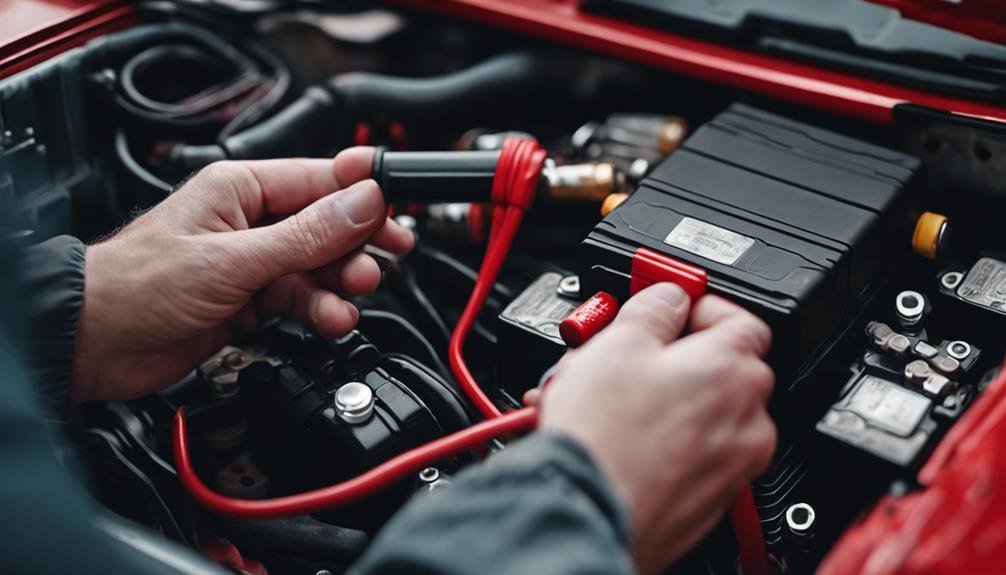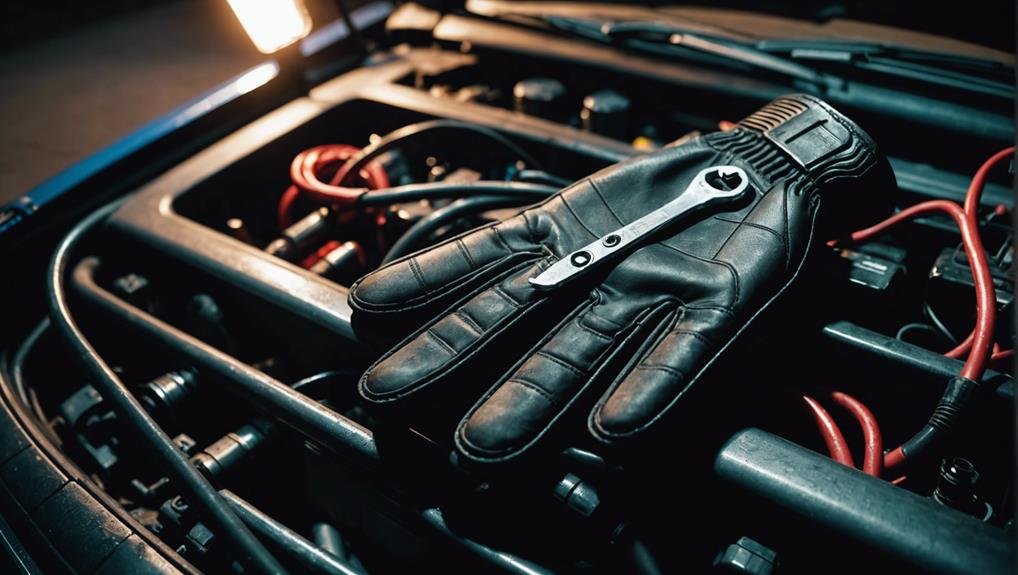When you need to safely unplug your car battery, start by preparing with gloves, goggles, and necessary tools. Locate the positive and negative terminals, marked with a plus sign and minus sign respectively, and remove the plastic caps. Disconnect the negative cable initially to prevent short circuits, then loosen the nut on the positive terminal. Remove the battery, taking care to avoid electrical contact. Cleaning the terminal contacts and reconnecting the cables securely will guarantee a safe and proper reconnection. By following these steps, you'll be well on your way to safely unplugging your car battery, and there's more to learn about maintaining your vehicle's electrical system.
Key Takeaways
- Wear gloves and goggles, and have the security code for the car radio before starting the process to ensure safety.
- Disconnect the negative (black) cable first to prevent short circuits, and then the positive (red) cable to ensure safe battery disconnection.
- Clean the terminal contacts regularly to improve electrical conductivity and extend the battery's lifespan by removing corrosion and grime.
- Reconnect the positive cable first, ensuring a snug fit, and apply anti-corrosion grease to prevent future corrosion and ensure secure connections.
- Perform post-disconnection safety checks, inspecting terminals, cables, and connections, and testing the battery voltage to ensure a safe and secure reconnection.
Preparing for Battery Disconnection
Before you start disconnecting your car battery, take a few important precautions to guarantee a safe and hassle-free process.
Initially, prioritize safety by wearing gloves and goggles to protect yourself from battery acid and electrical shocks. It's also vital to have the security code for your car's radio, so you can avoid any issues with functionality after reconnecting the battery.
Next, gather the necessary tools, including a socket wrench, which will help you securely disconnect the battery terminals. When removing the battery cables, keep in mind that the car chassis is connected to the negative side of the battery, so always remove the negative cable first to prevent short circuits and electrical accidents.
Locating the Battery Terminals
As you prepare to disconnect your car battery, identifying the positive and negative terminals is important to avoid any confusion or mistakes that could lead to electrical shocks or damage to your vehicle's electrical system.
To locate the terminals, start by removing any plastic caps that may be covering them. Once exposed, you'll notice that the positive terminal is typically marked with a plus sign (+) and is often red in color, while the negative terminal is marked with a minus sign (-) and is usually black.
It's vital to understand that the positive terminal is where the power flows into the battery, while the negative terminal is where the power flows out. Take a moment to familiarize yourself with the terminals, noting their location and color. This will help you confidently disconnect the battery cables in the correct order.
Disconnecting the Negative Cable

You'll start by disconnecting the negative cable, which is usually black and marked with a minus symbol on the battery terminal. This is an important step, as it prevents electrical accidents or short circuits.
To disconnect the negative cable, use a wrench to loosen the nut on the negative terminal. Once loose, carefully remove the cable from the battery. Make sure the negative cable is securely moved away from the battery to avoid accidental contact with any metal surfaces.
It's important to follow safety precautions, such as wearing gloves and safety glasses, when disconnecting the negative cable. This will prevent electrical shocks or other injuries. Remember, disconnecting the negative cable first is crucial to ensure your safety while working with the battery.
Removing the Positive Connector
Now that the negative cable is safely disconnected, you can proceed to remove the positive connector, which is typically marked with a '+' symbol.
Before you remove the positive connector, use a wrench to loosen the nut on the positive terminal. This will make it easier to disconnect the cable and prevent any damage to the electrical components.
Next, push the cable off the terminal, taking care not to touch any metal parts of the car with the positive cable to prevent accidental electrical contact.
As you remove the positive connector, keep in mind that this is an essential step in safely disconnecting the car battery for maintenance or replacement. Be sure to keep the red plastic cover on the positive terminal in place to prevent any accidental contact.
Safely Removing the Battery

How do you guarantee the battery is securely removed from the tray without causing damage or injury? To begin with, you'll need to disconnect the negative terminal initially to prevent electrical accidents. Use a socket wrench to unbolt the cables and remove them from the battery terminals. Don't forget to wear safety glasses and gloves to protect yourself from battery acid and potential electric shocks during the removal process.
Next, locate the hold-down clamp that secures the battery in place and loosen it. Carefully lift the battery out of the tray, taking note of its weight and potential for leakage. As you remove the battery, be mindful of any cables or wires that may still be attached. Once the battery is free from the tray, store it in a safe place away from the vehicle. Remember to handle it with care to avoid any accidents.
Cleaning the Terminal Contacts
To guarantee a strong connection between the battery and your car's electrical system, start by cleaning the terminal contacts to remove any corrosion or grime that may be hindering electrical conductivity. You'll need a wire brush, specifically a cup style or pipe cleaning wire brush, to scrub off corrosion and dirt from the terminal contacts.
Regular cleaning helps maintain a strong connection, improves electrical conductivity, and prevents voltage drops. Corrosion and grime can weaken the connection, leading to electrical issues, so it's vital to clean the terminal contacts regularly. By doing so, you'll extend the lifespan of your car battery and prevent electrical problems.
When cleaning, make sure to remove any dirt and grime that may have accumulated on the terminal contacts. This will ensure a secure connection between the battery and your car's electrical system, ensuring your car runs smoothly and efficiently. Remember, clean terminal contacts are important for efficient electrical conductivity and a healthy car battery.
Reconnecting the Battery Cables

After cleaning the terminal contacts, you're ready to reconnect the battery cables, starting with the positive cable to avoid any short circuits.
When reconnecting the positive cable, make sure it's securely attached to the positive battery post. Next, reconnect the negative cable to the negative post, ensuring a snug fit.
Before reconnecting, inspect the terminals for any signs of corrosion and apply anti-corrosion grease to prevent future corrosion.
Double-check that the cables are properly aligned and tightened securely to prevent electrical issues.
Use an adjustable wrench to tighten the nuts on the battery terminals to the manufacturer's specifications, which can be found in your owner's manual.
It's crucial to follow proper procedures when disconnecting your car battery to avoid damaging your electrical system. Always wear safety goggles to protect your eyes from any debris.
Post-Disconnection Safety Checks
You've disconnected your car battery, now it's important to perform a series of post-disconnection safety checks to guarantee a smooth and safe restart.
After disconnecting your battery, check for any signs of corrosion on the terminals, and inspect the battery cables for any wear or damage that may need attention. Make sure all connections are secure and tight before reconnecting the battery.
It's vital to test the battery voltage or have it tested to ensure it's still in good condition. Double-check that all components that were disconnected are properly reattached before starting the vehicle. Check your owner's manual for specific guidelines on the process of disconnecting and reconnecting your battery.
If you're unsure, consult an auto repair professional or consider replacing the battery with a new one. Remember to inspect the top of the battery for any signs of damage or wear.
Frequently Asked Questions
Which Battery Terminal Do I Disconnect First?
'When you're working with car batteries, you might wonder which terminal to disconnect initially. Remember, you should always unplug the negative terminal initially to prevent electrical shocks and short circuits.'
How to Disconnect Car Battery Safely?
When disconnecting your car battery, you'll want to take some vital precautions to avoid electrical shocks or acid spills. You should always turn off the ignition, wear protective gear, and identify the negative terminal before loosening the nut.
Is It Okay to Just Disconnect the Negative Terminal?
You're wondering if it's okay to just disconnect the negative terminal? Yes, it's sufficient for most tasks, as it cuts off the power supply, preventing accidental short circuits and electrical hazards.
Do I Disconnect the Positive or Negative When Working on a Car?
When working on your car, you should always disconnect the negative terminal initially, then the positive, to prevent electrical shocks and short circuits, ensuring your safety and protecting your car's electrical system.
Conclusion
You've successfully disconnected your car battery, ensuring a safe and hassle-free process. By following these steps, you've prevented any accidental short circuits, electrical shocks, or damage to your vehicle's electrical system.
Remember to store your battery in a well-ventilated area, away from open flames or sparks, and to reconnect it correctly when you're ready to start your engine again.
